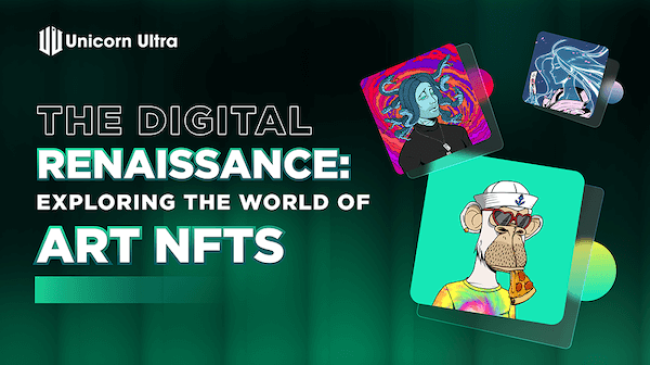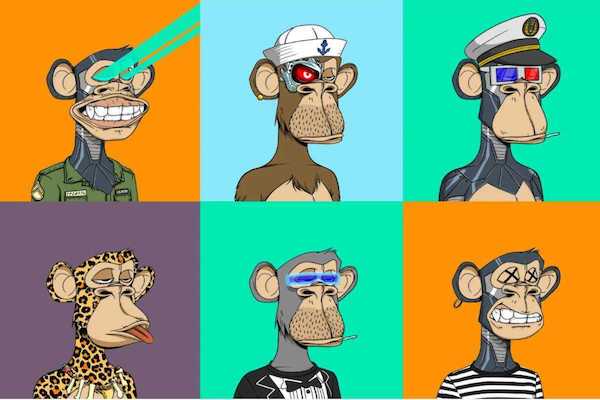Table of Contents
What is Art NFT?
NFT art constitutes a digital asset that, once acquired, allows the owner to sell or trade it within a blockchain platform. The sale of NFTs offers a method for selling digital art without the need for an extensive social network. Transactions occur on NFT marketplaces within the blockchain, thereby diminishing the hurdles associated with self-promotion.

Popular Types of Art NFTs
Digital Art NFTs: Digital artists create original artworks using digital tools and techniques, which are then tokenized as NFTs. These pieces often exist solely in the digital realm, but they can also be printed and displayed physically if the collector desires.
Traditional Art Digitization: Traditional artworks, such as paintings and sculptures, can be digitized and tokenized as NFTs. This process bridges the gap between physical and digital art, enabling traditional artists to enter the NFT space.
Interactive and Generative Art NFTs: Some NFT art pieces are interactive or generative, responding to user input or following algorithms to create dynamic and ever-evolving digital art forms.
How do NFTs differ from traditional art?
NFT art and traditional art exhibit numerous distinctions. In certain instances, NFT art may prove to be more lucrative due to the artist's ability to determine the commission percentage. Unlike traditional art, NFT art can be resold, with the artist receiving royalties with each subsequent sale. Additional noteworthy differences include:

-
Storage: Traditional physical art necessitates physical storage space, whereas NFT art relies on digital files securely stored through blockchain technology.
-
Selling Venues: Traditional art can be marketed through various channels, including online platforms, art galleries, and auction houses. In contrast, NFT art is exclusively traded on online NFT marketplaces.
-
Audience: NFT art can potentially reach a broad audience online, whereas traditional art may have a limited reach if displayed in a gallery or auction house.
-
Market Volatility: The value of NFTs is not solely determined by economic factors; it can also be influenced by social trends and relevancy, making the NFT market inherently volatile. Traditional art markets may be more stable in this regard.
What are the advantages of Art NFTs when compared to traditional art?
Provenance and Ownership: Art NFTs provide a transparent and immutable record of ownership and provenance, reducing the risk of art fraud and forgery.
Accessibility: Art NFTs democratize art ownership, allowing collectors to access and own pieces of art that may have been previously out of reach.
Digital Flexibility: Digital art NFTs can be displayed on various digital devices and shared online, making them versatile and easily accessible to a global audience.
Royalties and Resale Benefits: Artists can receive royalties every time their NFT artwork is resold, creating ongoing support for artists even after the initial sale.
Decentralization: Art NFTs are not subject to the control of centralized institutions, allowing for greater creative freedom and autonomy for artists.
Some Famous Art NFT Pieces

- "Everydays: The First 5000 Days" by Beeple: This monumental NFT artwork by digital artist Beeple sold at auction for a staggering $69 million, propelling NFT art into the mainstream.
- "CryptoPunk #7804" by CryptoPunk: CryptoPunks are one of the earliest and most iconic NFT projects. Punk #7804, a rare alien CryptoPunk, was sold for over $7 million.
- "Crossroads" by Beeple: Another Beeple creation, "Crossroads," was sold for $6.6 million, further cementing his status as a leading NFT artist.
- "The First Twitter" by Jack Dorsey: Twitter's CEO Jack Dorsey sold his first tweet as an NFT for $2.9 million, marking a historic moment in the convergence of social media and NFTs.
Conclusion:
Art NFTs have ushered in a new era of artistic expression, ownership, and engagement. These tokens are rewriting the rules of the art world, providing artists with unprecedented opportunities and collectors with new ways to engage with art.
As Art NFTs continue to push the boundaries of creativity and technology, they promise to redefine the future of art for generations to come. Whether you're an artist, collector, or simply an admirer of art, the world of Art NFTs is an exciting space to explore and participate in the digital renaissance of art.
I hope that through this U2U article, you will find answers to the question 'What is NFT art?' and also discover how to participate in the NFT market.






